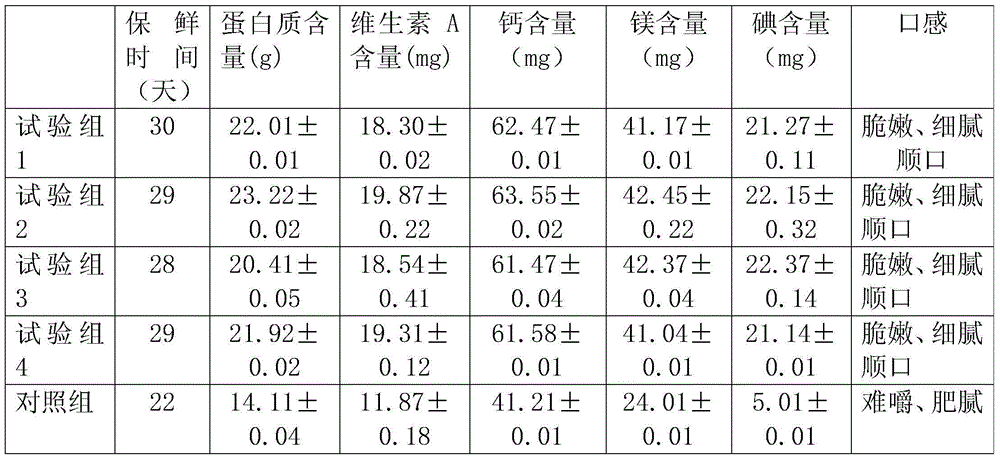Fresh keeping method of octopus
A fresh-keeping method and octopus technology, applied in the direction of using chemicals to preserve meat/fish, etc., to achieve good nutritional content and flavor, low cost of fresh-keeping, and no toxic and side effects
- Summary
- Abstract
- Description
- Claims
- Application Information
AI Technical Summary
Problems solved by technology
Method used
Image
Examples
Embodiment 1
[0018] A fresh-keeping method for octopus, comprising the following steps:
[0019] 1) Choose a fresh octopus, cut it from the abdomen, cut the octopus into two pieces, then peel off the octopus skin; then remove the ink sac and bones in the octopus abdomen, then rinse twice with running water, drain, spare;
[0020] 2) Put the octopus treated in step 1) into the Chinese medicinal liquid and soak for 35 minutes, remove and set aside; wherein, the Chinese medicinal liquid is made of the following components by weight: 10 parts of forsythia, 15 parts of honeysuckle, 8 parts of wolfberry, 10 parts of magnolia, 2 parts of Fangfeng, 16 parts of Speranthum, 15 parts of white peony, 10 parts of astragalus;
[0021] 3) Soak the octopus treated in step 2) in sterile water for 3 minutes, take it out, rinse it twice with flowing sterile water, dry it with sterile air in a sterile environment, and set it aside;
[0022] 4) Put the octopus processed in step 3) into the aseptic box, then ...
Embodiment 2
[0025] A fresh-keeping method for octopus, comprising the following steps:
[0026] 1) Choose a fresh octopus, cut it from the abdomen, cut the octopus into two pieces, and then peel off the octopus skin; then remove the ink sac and bones in the octopus abdomen, then rinse it with running water for 3 times, drain, spare;
[0027] 2) Put the octopus treated in step 1) into the Chinese medicinal liquid and soak for 22 minutes, remove and set aside; wherein, the Chinese medicinal liquid is made of the following components by weight: 15 parts of forsythia, 5 parts of honeysuckle, 15 parts of Chinese wolfberry, 5 parts of magnolia, 8 parts of Fangfeng, 8 parts of Speranthema, 20 parts of white peony, 20 parts of Astragalus;
[0028] 3) Soak the octopus treated in step 2) in sterile water for 2 minutes, take it out, rinse it once with flowing sterile water, dry it with sterile air in a sterile environment, and set it aside;
[0029] 4) Put the octopus treated in step 3) into the a...
Embodiment 3
[0032] A fresh-keeping method for octopus, comprising the following steps:
[0033] 1) Choose a fresh octopus, cut it from the abdomen, cut the octopus into two pieces, and then peel off the octopus skin; then remove the ink sac and bones in the octopus abdomen, then rinse it with running water for 3 times, drain, spare;
[0034] 2) Put the octopus treated in step 1) into the Chinese medicinal liquid and soak for 28 minutes, remove and set aside; wherein, the Chinese medicinal liquid is made of the following components by weight: 12 parts of forsythia, 10 parts of honeysuckle, 13 parts of wolfberry, 7 parts of magnolia, 5 parts of Fangfeng, 12 parts of Sperantosperm, 17 parts of white peony, 15 parts of astragalus;
[0035] 3) Soak the octopus treated in step 2) in sterile water for 3 minutes, take it out, rinse it with flowing sterile water for 1 to 2 times, dry it with sterile air in a sterile environment, and set it aside;
[0036] 4) Put the octopus treated in step 3) in...
PUM
 Login to View More
Login to View More Abstract
Description
Claims
Application Information
 Login to View More
Login to View More - R&D
- Intellectual Property
- Life Sciences
- Materials
- Tech Scout
- Unparalleled Data Quality
- Higher Quality Content
- 60% Fewer Hallucinations
Browse by: Latest US Patents, China's latest patents, Technical Efficacy Thesaurus, Application Domain, Technology Topic, Popular Technical Reports.
© 2025 PatSnap. All rights reserved.Legal|Privacy policy|Modern Slavery Act Transparency Statement|Sitemap|About US| Contact US: help@patsnap.com

